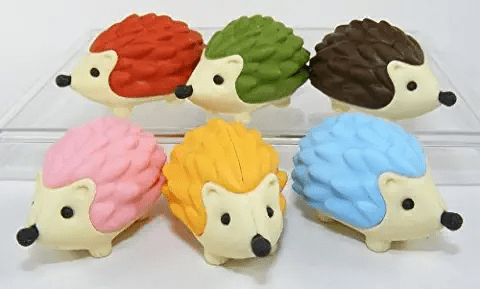I don’t know why, but students absolutely love these Iwako hedgehog erasers! They actually come apart into five pieces. I thought I would share how the many different ways I use these cute erasers in piano class.
- When teaching beginners, have them put an eraser on specific piano keys, eg. all the C’s. all the F’s. First they play all the C’s, for example, later on in the class, put one eraser on one C.
- Once the students know all the piano keys, play a keyboard game. Put an eraser at either end of the piano. One end belongs to the student and the other end belongs to the teacher. Call out a letter name, and the student moves his/her eraser towards the middle to that piano key. Call out another letter name, and the teacher moves his/her hedgehog to that piano key. You have a race towards middle C. Instead of calling out letter names, you could put the letters on cards (turn them over, and pick a card) or use a spinner. It’s a game, but a sneaky way to see if the students know the names of the piano keys.
- Teach whole tones and semi-tones by putting erasers on piano keys. Once you’ve taught whole tones and semi-tones, ask them to build what you call out.
- Teach major scales by putting erasers on the piano keys, T T S T T T S (T = whole tone, S = semi-tone).
- Find relative minor keys. Put an eraser on a piano key, then count down three semi-tones to find the relative minor.
- Teach natural, harmonic and melodic minor scales putting erasers on the piano keys.
- Teach major triads. Build a root position triad, ex. C E G, on the piano keys, then first and second inversion. Teach the student how to find root, quality and position.
- Once students have learned major triads, show them how to make the triad minor, diminished and augmented putting erasers on the piano keys.
- Teach intervals using erasers on the piano keys. Teach them to find the distance first (for example, fifth), then the quality next (perfect or major). Is the top note part of the bottom note’s major scale? If yes, the interval is either major or perfect. If not, is the top note bigger or smaller than the major or perfect interval?
- Teach dominant sevenths and inversions putting erasers on the piano keys.
- Teach diminished sevenths and inversions putting erasers on the piano keys.
- Teach scale degrees putting erasers on the piano keys.
- Teach modes putting erasers on the piano keys. This mnemonic device helps you remember the mode order: I Do Play Like Mozart And Liszt (Ionian, Dorian, Phrygian, Lydian, Mixolydian, Aeolian and Locrian). Ionian is a major scale from first degree to first degree, Dorian is a major scale from second degree to second degree, Phrygian is a major scale from third degree to third degree, etc.
Amazon no longer has the eight hedgehog package, but you can purchase a six colour package Iwako Puzzle Japanese Erasers. Yep, to build scales, you will need two six-piece packages.
Teachers say they don’t have the time to play a game, but once you’ve taught a concept, it takes no time to review it with erasers. Ask one question (or two), the student builds it, put the erasers away, and you can move on.
Do you have any other creative ideas/games with the Iwako erasers? If you do, make sure you comment below.

Learning music theory can be an important part of becoming a skilled musician, but it can also be a dry and boring subject for some people. Here are a few creative ways to make learning music theory more enjoyable and engaging:
Use mnemonic devices: Mnemonic devices are memory aids that can help you remember complex concepts in music theory. For example, to remember the order of the notes on the treble clef, you can use the phrase “Every Good Boy Deserves Fudge” (EGBDF).
Make flashcards: Flashcards are a simple but effective tool for learning and reviewing music theory concepts. You can make your own flashcards using index cards and write a music theory concept on one side and the corresponding definition on the other. Then, you can quiz yourself or have someone else quiz you to test your knowledge.
Play games: Learning doesn’t have to be all work and no play. There are many games and quizzes available online or in app form that can help you learn and review music theory concepts in a fun and engaging way.
Use online resources: There are many online resources, such as websites, videos, and interactive games, that can help you learn and review music theory concepts. These resources can be a great supplement to traditional music theory lessons, and can make the learning process more engaging and enjoyable.